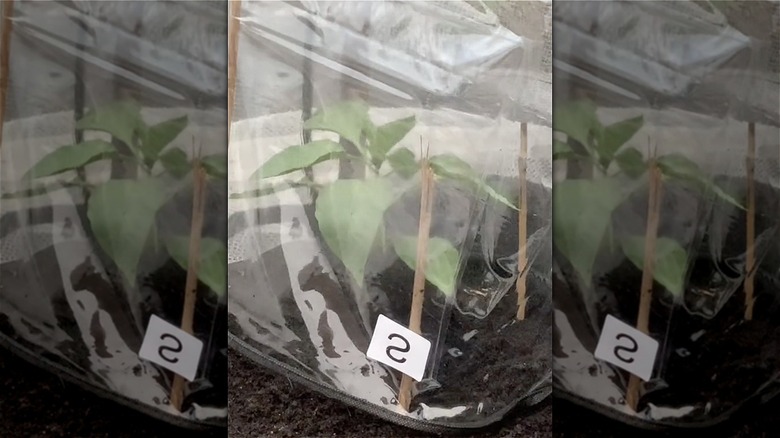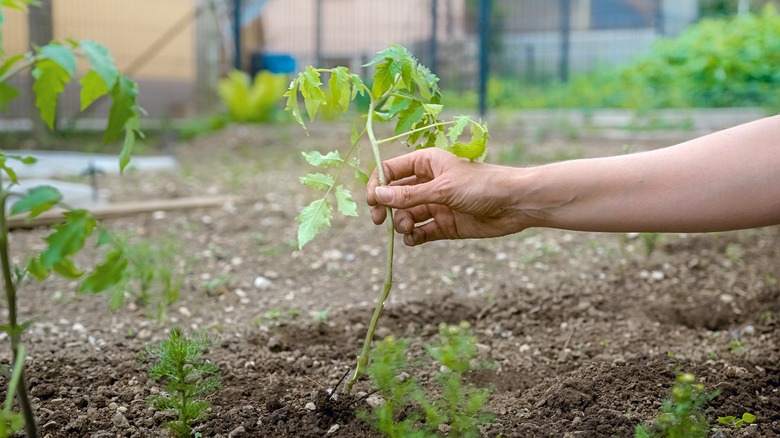We may receive a commission on purchases made from links.
You know those heavy-duty plastic zippable cases in which new pillows, sheets, and blankets come? It probably comes as no surprise that they’re durable enough to hold their own outside — extreme weather events aside. If you’ve planted seedlings that need protection, you can turn that packaging into a shelter. What’s more, since they’re typically made from transparent plastic, they act as a mini greenhouse, ramping up humidity and heat around the plant. This helps your tender wee tomatoes, lettuce, and string beans survive dry or cold spells. Best of all, all you need to craft this makeshift seedling cover is said bedding packaging and four sticks.
Getting indoor seedlings ready to plant in the ground can be challenging. Plant them outdoors too early, and they succumb to unexpected late frosts. Even if you get them outside at the right time, you’ll deal with predation from exoskeletal, feathered, and furred garden visitors. This surprisingly sturdy bedding packaging shelter protects vulnerable seedlings from all of these incursions. Best of all, larger bags can protect multiple seedlings at once, making your time in the garden even more efficient.
Gather your materials

@busychrisgardening / TikTok
You probably don’t buy bed linens that often. If you want to make this a regular thing in your garden, ask family members, friends, and neighbors to save their bedding packaging and pass it on to you. You’ll have all the teeny greenhouses you need and save all that plastic from landfills. Any flexible, cube-shaped packaging with four corners will do the job. If no one you know has any bags to share, ask your local Buy Nothing group (the website has a finder) or similar community-sharing forums. To make your frame, measure the height of the greenhouse from where the packaging opens to the closed end. That’s how long your sticks need to be (to reduce the chance of pests gathering inside your greenhouse, you want the opening sitting on the dirt).
Material-wise, anything will do — lengths of thin plastic pipe, bamboo, wood — even branches from that shrub you pruned recently, stripped of their leaves and dried. Cut the sticks to the required length, if necessary. If you really need to buy frame material, Walmart sells a set of 16 5-foot-tall, half-inch-wide natural bamboo garden stakes for $18.50 delivered, at the time of writing. Landscape staples would work, too, like these 6-inch stakes by HOOPLE on Amazon — $15.99 for a set of 100. Given their shape, you might only need two of them per package.
Get making

Clean the packaging with warm (not hot or you’ll melt the plastic) water with a little dish soap in it. Dry it overnight. Identify the seedling you wish to protect, and stand the bag next to it. You need to ensure at least a few inches of space between the top of the seedling and the roof of the plastic packaging.
Place the bag over the seedling (or seedlings) and make an indent in the dirt using one of the sticks at each corner. Carefully lift the packaging off the seedling again and drive a stick into the soil at each indent. Place the bag over the rods, adjusting as necessary, so they fit snuggly into each corner. The packaging should sit firmly on the soil. This works if you’re growing a container garden, too. Choose packaging with dimensions that fit just within the limits of the planter in question, insert the sticks right at the outer edges of the planter, and fit the bag over them just as you would in the garden.
To water the plant inside, gently lift the cover and wet the soil around the stem with a spray bottle or hose. If protection is no longer required for a seedling, take the packaging off, use it on another seedling, or clean and store it for future seasons in a dry, dark, cool place — say, a garden shed or garage. Note that most plastic is vulnerable to deterioration when exposed to high heat and UV radiation.



